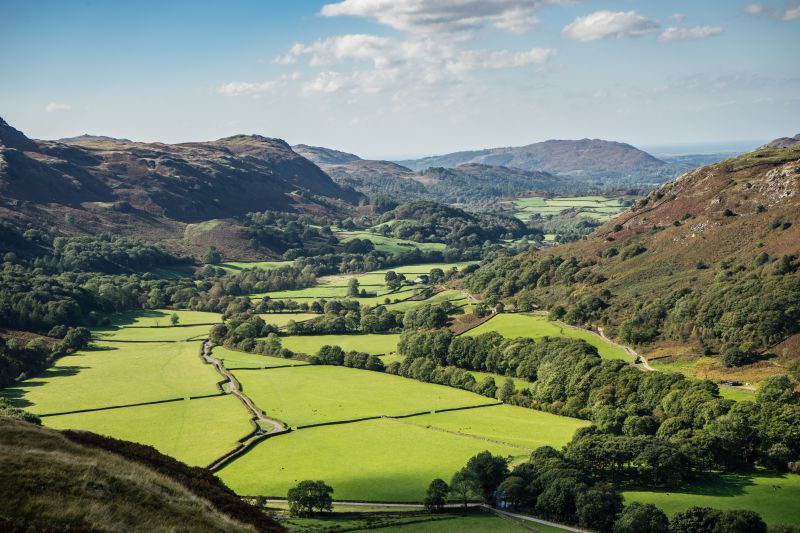
The photo shows a classic glaciated valley with the green fertile land in the foreground. Hay or silage may be made from these grassy lowland fields. The farmer may own or manage the land in the valley and on the fell as well as the in-take land.
From the photo there are several clues to the time of year, the green colour of the fields, the green leaves on the trees and the quality of sunlight. These all suggest summer.
The upland climate of the Lake District is harsh with low temperatures, high rainfall, thin soils and exposed steep gradients. This limits the type of farming that can be practised here, the most common being hill sheep farming but cattle are grazed in lowland areas. Herdwick sheep, which were reputedly brought in by the Vikings, are well adapted for coping with wet and cold conditions and are probably the most hardy breed in Britain. Strong, healthy sheep will thrive on the fells but lambing losses can be as high as 25% due to parasites, bad weather and poor grazing.
The farming year follows a regular cycle:
late November: Tups (male sheep) are mated with the ewes on the in-bye (valley bottom land)
Around Christmas: the ewes are returned to the fell
April: in the warmer spring weather, ewes return to lamb on the in-bye. The gestation period for a sheep is 5 months (150 days). Sheep are marked with a colour or number, as well as an ear mark, to identify them once they are out on the fells.
May: Ewes with single lambs are returned to the fell whereas ewes with twin lambs are kept lower down until clipping time.
July and August: Sheep are clipped
Shearing costs can be 80p per sheep and in most areas Herdwick fleece is not worth more than a couple of pence per fleece due to its grey colour and poor quality. However local diversification schemes are using Herdwick fleeces to make thermal loft insulation, carpets, army clothing and stylish woollen blankets. These are some of many farm diversification schemes for Cumbrian hill farmers who are having to be creative to raise their farm's income.
September: Lambs are weaned from their mothers.
Young male lambs (wethers) are sold on to other farmers or kept for fattening and selling on for meat sometime before their first birthday. Herdwick meat has a distinctively strong flavour. It was eaten at the Queen's Coronation dinner in 1953.
Young female lambs (gimmers) are sent away to winter on lowland farms. When they return in the spring they are put to the fell to find the 'heaf' where they suckled their mothers and they are now in turn 'hefted' to continue the cycle of sheep grazing on a particular fell territory.
Agriculture has played a huge part in shaping the landscape of the Lake District. The existing pattern of habitats reflects the area’s strong history of farming. In the absence of grazing, much of the land would revert to oak woodland, the main form of vegetation.
Grid reference of Hill Fort: 218015 (English Lakes SW 1:25,000)
Herdwick, fleece, ewe, tup, wether, gimmer, hefted, valley, fell, silage, diversification
From the light in the picture, what time of year is it likely to be?
Why is the middle area flat and green?
Where is the farm?
Where does the road go?
If there were no sheep in the valley what features of the landscape might change?
What might there be out of view around the edges of the photo?
Why is hill farming different to other types of farming?
Discuss farmers’ lifestyles, farm diversification, farmers’ markets.
all open in new window: